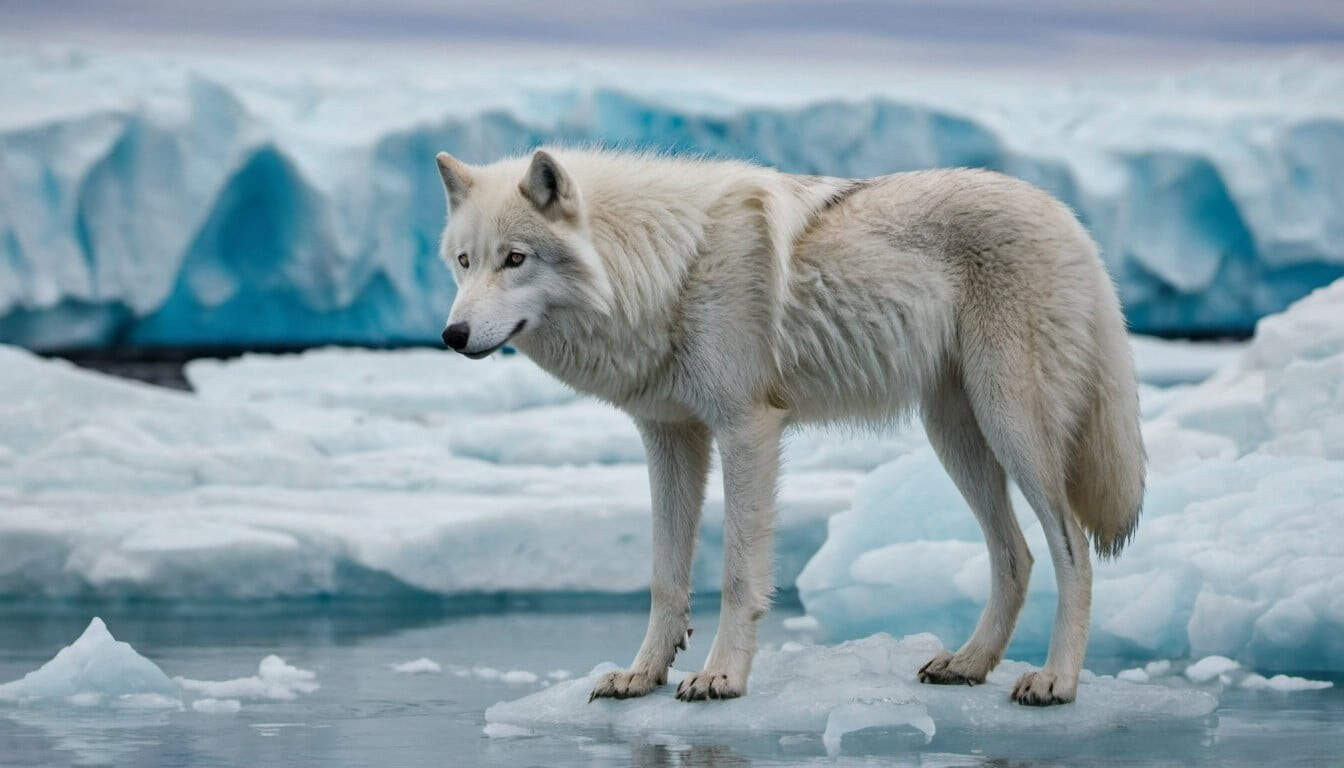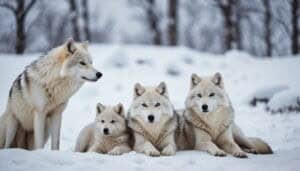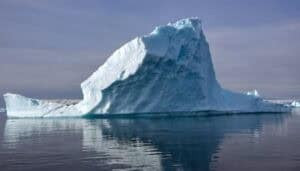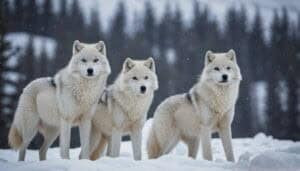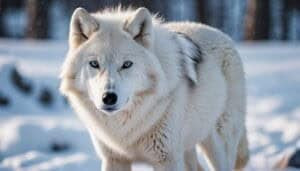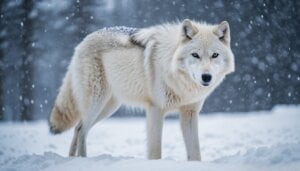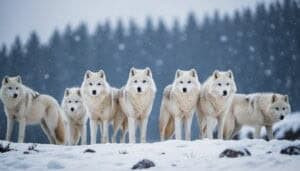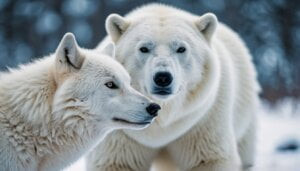Introduction
Climate change is having a profound impact on the Arctic ecosystem, and Arctic wolves are among the species most affected
This article explores the multifaceted ways in which climate change is altering their territories. We will delve into the changes in their habitat, the impact on their prey, and the adaptive strategies these resilient animals employ
Additionally, we’ll examine the long-term survival prospects for Arctic wolves in a warming world and highlight recent scientific findings on their behavior. Finally, we will discuss ongoing conservation efforts aimed at protecting these iconic predators from the detrimental effects of climate change
The Changing Habitat of Arctic Wolves
The habitat of Arctic wolves is undergoing significant changes due to the rapid warming of the Arctic. These changes are altering the landscape in which these wolves live, hunt, and breed, creating a range of challenges for their survival
As ice and snow cover diminish, the traditional hunting grounds and territories of Arctic wolves are shrinking, impacting their ability to find food and secure safe spaces for raising their young
Effects of Melting Ice and Snow
Melting ice and snow are the most immediate and visible impacts of climate change in the Arctic
This loss of ice has several consequences for Arctic wolves:
Loss of Hunting Grounds: Arctic wolves rely heavily on the ice to hunt for prey such as seals and other marine mammals. As the ice retreats, these prey species become harder to access, leading to food shortages for the wolves
Reduced Mobility: The ice serves as a natural bridge, allowing wolves to travel vast distances in search of food. With the ice melting, these natural pathways are disappearing, restricting the wolves’ range and isolating populations
Increased Risk: Thinner ice poses a direct threat to wolves that venture onto it, increasing the risk of drowning or injury
According to a study published in “Nature Climate Change” (2017), the Arctic is warming twice as fast as the global average, leading to an unprecedented rate of ice loss. This accelerated melting is expected to continue, further reducing the habitat available to Arctic wolves
Alterations in Vegetation and Prey Availability
The changing climate is also altering the vegetation in the Arctic, which in turn affects the prey availability for Arctic wolves:
Vegetation Shifts: Warmer temperatures are causing a northward shift in vegetation zones, with tundra landscapes giving way to shrubs and even forested areas. This shift impacts the distribution and abundance of herbivores like caribou and musk oxen, which are key prey for Arctic wolves
Prey Decline: Some prey species are struggling to adapt to the rapid environmental changes. For instance, the population of lemmings, a crucial food source, has been observed to fluctuate more drastically due to unpredictable weather patterns, leading to periods of scarcity for predators like Arctic wolves
Research conducted by the International Arctic Science Committee (2020) indicates that these changes in vegetation and prey dynamics are likely to continue, posing ongoing challenges for Arctic wolf populations
Shifts in Territorial Boundaries
As their environment changes, Arctic wolves are being forced to adapt by shifting their territorial boundaries:
Increased Competition: With their traditional territories shrinking, Arctic wolves are moving into new areas, often resulting in increased competition with other predators, including human hunters and domestic dogs
Fragmentation: The loss of continuous ice cover and changing vegetation patterns are fragmenting the territories of Arctic wolves, leading to isolated populations that are more vulnerable to genetic bottlenecks and reduced resilience
A study by the University of Alaska Fairbanks (2019) highlights that the fragmentation of Arctic wolf territories is leading to decreased genetic diversity and increased vulnerability to disease and other environmental stresses
Impact of Climate Change on Arctic Wolf Prey
The prey base of Arctic wolves is critical to their survival and reproductive success. Climate change is having a profound impact on the availability and behavior of these prey species, creating significant challenges for Arctic wolves
Changes in prey populations, migration patterns, and distribution are all contributing to the difficulties Arctic wolves face in securing adequate food
Decline in Prey Species
Several prey species that Arctic wolves depend on are experiencing population declines due to climate change:
Lemmings and Small Mammals: Lemmings, a staple food for Arctic wolves, are facing fluctuating populations due to unstable snow conditions, which affect their breeding and survival rates. According to a study published in “Ecology Letters” (2018), the cyclic population peaks of lemmings are becoming less predictable, impacting predators that rely on them
Caribou and Musk Oxen: Caribou and musk oxen are also experiencing stress from changing climatic conditions. Warmer winters and increased freeze-thaw cycles lead to ice layers that block access to forage, causing declines in these populations and reducing the availability of prey for Arctic wolves
Changes in Prey Migration Patterns
Climate change is altering the migration patterns of many prey species, affecting their availability to Arctic wolves:
Caribou Migration: Caribou herds, which are a significant prey for Arctic wolves, are altering their migration routes in response to changing snow and vegetation patterns. This unpredictability makes it harder for wolves to locate and hunt these animals. Research by the University of Washington (2020) shows that altered migration patterns are leading to mismatches in timing and location between predators and prey
Birds and Marine Mammals: Some bird species and marine mammals are also changing their migratory behaviors due to warming temperatures and shifting food sources. This can lead to periods of food scarcity for Arctic wolves during certain times of the year
Impact on Hunting Strategies
The changes in prey availability and behavior are forcing Arctic wolves to adapt their hunting strategies:
Increased Opportunistic Hunting: With traditional prey becoming less reliable, Arctic wolves are turning to more opportunistic hunting. This includes scavenging more frequently and hunting smaller or less typical prey species
Altered Pack Dynamics: The need to cover larger areas to find food is affecting pack cohesion and hunting efficiency. Larger territories mean more energy expenditure and potential conflicts with other packs or predators
A study by the Canadian Wildlife Service (2021) highlights how Arctic wolves are showing remarkable adaptability in their hunting strategies but notes that these changes may not be sustainable in the long term if prey availability continues to decline
Adaptation Strategies of Arctic Wolves
Arctic wolves are resilient and resourceful animals, and their survival depends on their ability to adapt to the rapidly changing conditions in the Arctic. As their habitat and prey availability are affected by climate change, Arctic wolves are employing a range of adaptation strategies to cope with these challenges
Behavioral Changes
Arctic wolves are exhibiting various behavioral adaptations in response to the changing environment:
Altered Hunting Techniques: With prey becoming scarcer and more unpredictable, Arctic wolves are modifying their hunting techniques. They are spending more time searching for food and are more frequently hunting in smaller packs to increase efficiency and reduce competition within the group
Extended Territories: In search of food, Arctic wolves are expanding their territories. This often means traveling greater distances and venturing into new and unfamiliar areas, which can lead to encounters with other wolf packs or human settlements
A study published in “Behavioral Ecology” (2022) observed that Arctic wolves are increasingly adopting solitary hunting behaviors, particularly during the breeding season, to optimize their chances of securing enough food for their pups
Physical Adaptations
The physical characteristics of Arctic wolves are also showing signs of adaptation to the changing climate:
Dietary Flexibility: Arctic wolves are known for their dietary flexibility, and they are increasingly relying on a broader range of food sources, including scavenging on carrion and preying on smaller animals that are more readily available
Thicker Fur Coats: To cope with the variability in temperature, some Arctic wolves are developing thicker fur coats to protect themselves against the cold snaps that still occur despite overall warming trends
Research from the University of Calgary (2021) indicates that Arctic wolves are demonstrating physiological plasticity, which allows them to survive in a wider range of environmental conditions compared to other wolf species
Shifts in Social Structure
The social structure of Arctic wolf packs is adapting to the pressures exerted by climate change:
Smaller Pack Sizes: There is a trend towards smaller pack sizes, which helps reduce the competition for limited food resources. Smaller packs are also more agile and can cover larger areas more efficiently
Flexible Leadership: Pack dynamics are becoming more fluid, with leadership roles changing more frequently depending on the availability of resources and the challenges faced by the pack
A study by the Wildlife Conservation Society (2020) found that these social adaptations are crucial for the survival of Arctic wolves, as they enable packs to be more responsive to changing conditions and resource availability
Long-term Survival Prospects for Arctic Wolves
The long-term survival prospects for Arctic wolves are uncertain as climate change continues to alter their environment. This section explores the factors that influence their future, including population viability, threats from increased human activity, and the role of conservation efforts
Population Viability in Warming Climates
As the Arctic warms, the population dynamics of Arctic wolves face significant changes:
Reduced Reproductive Success: Warmer temperatures and changing prey availability can lead to lower reproductive success. Pups may have higher mortality rates due to nutritional stress and harsher environmental conditions
Inbreeding Risks: Fragmentation of habitats can lead to isolated wolf populations, increasing the risk of inbreeding and reducing genetic diversity. This can make Arctic wolves more susceptible to diseases and genetic disorders
A report from the International Union for Conservation of Nature (IUCN, 2022) highlights that maintaining genetic diversity is crucial for the long-term survival of Arctic wolves, and fragmented populations pose a significant threat
Threats from Increased Human Activity
Human activities in the Arctic are intensifying due to climate change, posing additional threats to Arctic wolves:
Resource Exploration: Oil and gas exploration, as well as mining activities, are increasing in the Arctic. These activities can lead to habitat destruction, pollution, and increased human-wildlife conflicts
Tourism and Development: As the Arctic becomes more accessible, tourism and infrastructure development are expanding. This leads to habitat fragmentation and increased disturbances for wildlife
According to a study by the World Wildlife Fund (WWF, 2023), human encroachment into Arctic wolf territories is leading to higher incidences of poaching and accidental killings, further threatening their populations
Role of Conservation Efforts
Conservation efforts play a crucial role in protecting Arctic wolves from the adverse effects of climate change:
Protected Areas: Establishing and enforcing protected areas can help preserve critical habitats for Arctic wolves and their prey. These areas can serve as refuges where wolves can find food and breed without human interference
Research and Monitoring: Ongoing research and monitoring are essential to understand the impacts of climate change on Arctic wolves and to develop effective conservation strategies. This includes tracking population trends, health, and genetic diversity
Community Involvement: Engaging local communities in conservation efforts can foster coexistence and reduce human-wolf conflicts. This can include education programs, sustainable tourism practices, and incentives for protecting wildlife
The Arctic Wolf Conservation Project (AWCP, 2021) has been actively involved in these initiatives, working to mitigate the impacts of climate change and human activities on Arctic wolf populations
Scientific Findings on Arctic Wolf Behavior
Scientific research provides valuable insights into how Arctic wolves are responding to climate change. This section highlights recent studies and discoveries, observations of behavior changes, and predictions for future adaptations
Recent Studies and Discoveries
Recent scientific studies have shed light on the various ways Arctic wolves are adapting to their changing environment:
Behavioral Adaptations: A study published in “Global Change Biology” (2021) found that Arctic wolves are altering their hunting strategies and pack dynamics to cope with reduced prey availability. Wolves are spending more time scavenging and are hunting smaller, more abundant prey
Genetic Studies: Research from the University of Toronto (2020) revealed genetic adaptations in Arctic wolves that may help them survive in warmer climates. These adaptations include genes related to metabolism and temperature regulation
Observations of Behavior Changes
Field observations provide direct evidence of how Arctic wolves are changing their behaviors in response to climate change:
Increased Scavenging: Observations by wildlife biologists in the Canadian Arctic (2022) indicate that Arctic wolves are increasingly scavenging on carrion, including remains left by polar bears and human hunters. This shift helps them cope with the scarcity of live prey
Altered Breeding Seasons: Changes in climate are affecting the breeding patterns of Arctic wolves. Warmer temperatures and shifting prey availability are leading to earlier breeding seasons, as noted in a study by the University of Alaska (2021)
Predictions for Future Adaptations
Scientists are making predictions about how Arctic wolves might continue to adapt as climate change progresses:
Further Range Shifts: As the Arctic continues to warm, it is likely that Arctic wolves will move further north and into higher elevations in search of suitable habitats. This shift will require continued adaptation to new prey and environmental conditions
Hybridization: There is potential for increased hybridization between Arctic wolves and other wolf species, such as gray wolves, as their ranges overlap more frequently. This could introduce new genetic traits that might help Arctic wolves survive in changing environments
A review article in “Frontiers in Ecology and Evolution” (2022) suggests that while Arctic wolves are showing remarkable adaptability, their long-term survival will depend on the rate of environmental change and the effectiveness of conservation measures
Conclusion
The impact of climate change on Arctic wolf territories is profound and multifaceted. Melting ice, changing vegetation, and shifting prey dynamics are reshaping the habitat and survival strategies of these resilient predators
Arctic wolves are adapting through behavioral, physical, and social changes, but their long-term prospects remain uncertain. Increased human activity and habitat fragmentation pose additional threats, emphasizing the need for effective conservation efforts
Scientific research continues to uncover new insights into the adaptability of Arctic wolves, providing hope that with targeted protection and sustainable practices, these iconic animals can continue to thrive in a rapidly changing Arctic
